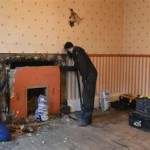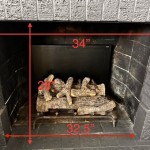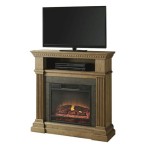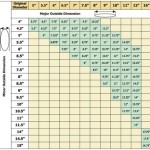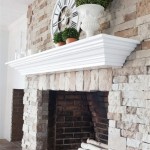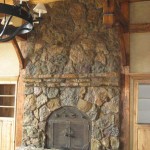Understanding Gas Logs for Fireplaces
Gas logs offer a convenient and efficient alternative to traditional wood-burning fireplaces. They provide the ambiance and visual appeal of a real fire without the mess, labor, and potential hazards associated with wood. This article explores the different types of gas logs, their benefits, installation considerations, and maintenance requirements.
The primary function of gas logs is to provide a realistic-looking flame within an existing fireplace. They are typically made from ceramic or refractory cement and are designed to mimic the appearance of natural wood. The logs are arranged in a specific configuration over a gas burner, creating a visually appealing fire that generates heat. The fuel source for gas logs is either natural gas or propane, depending on the availability and connection to the home's gas line.
### Types of Gas Logs: Vented vs. Vent-FreeGas logs are broadly categorized into two main types: vented and vent-free. The choice between the two depends on various factors, including existing fireplace structure, local regulations, and personal preferences.
Vented Gas Logs: These logs require a fully functional chimney or flue to vent combustion byproducts, such as carbon monoxide, outside the home. Vented gas logs produce a more realistic flame appearance, often with taller and more flickering flames, resembling a traditional wood-burning fire. However, they are less energy-efficient because a significant portion of the heat generated is lost up the chimney along with the exhaust gases. This is because the damper must remain fully open during operation to ensure proper ventilation.
The installation of vented gas logs is typically simpler than vent-free models, especially if the fireplace is already equipped with a functioning chimney. The existing fireplace must meet specific safety standards, including proper chimney drafting and clearance requirements. Regular chimney inspections and cleaning are essential to prevent blockages and ensure safe operation.
Vent-Free Gas Logs: Also known as ventless gas logs, these models do not require a chimney or flue for ventilation. They are designed to burn very cleanly, producing minimal amounts of carbon monoxide. Vent-free gas logs are equipped with an Oxygen Depletion Sensor (ODS), which automatically shuts off the gas supply if the oxygen level in the room drops below a certain threshold, preventing carbon monoxide poisoning.
Because vent-free gas logs do not vent combustion byproducts, they are more energy-efficient than vented models. The heat generated is retained within the room, making them suitable for supplemental heating. However, vent-free gas logs may produce slightly more moisture in the air, which could be a concern in poorly ventilated spaces. They also may produce a faint odor during operation, particularly when new or during initial use.
Installation of vent-free gas logs requires careful attention to manufacturer's instructions and local building codes. Gas logs are not permitted in some jurisdictions. Proper room size and ventilation are crucial to ensure safe operation. The ODS must be tested regularly to verify its functionality. It's also recommended to install a carbon monoxide detector in the room as an additional safety measure.
### Benefits of Using Gas LogsCompared to traditional wood-burning fireplaces, gas logs offer several advantages that make them a popular choice for homeowners.
Convenience: Gas logs eliminate the need to chop, stack, and store wood. They ignite instantly with the simple push of a button or the flip of a switch, providing immediate warmth and ambiance. There is no need to build or tend the fire, making them a convenient option for busy individuals or those who prefer a hassle-free alternative.
Cleanliness: Gas logs produce significantly less mess than wood-burning fireplaces. There is no ash, soot, or creosote to clean up, reducing the maintenance required and preventing chimney fires. The absence of wood debris also eliminates the risk of insects and rodents infesting the home.
Efficiency: While vented gas logs are less energy-efficient than their vent-free counterparts, both types offer better heating efficiency compared to traditional wood-burning fireplaces. Wood-burning fireplaces often lose a significant amount of heat up the chimney, whereas gas logs retain more heat within the room, providing supplemental heating.
Safety: Gas logs, when installed and used properly, are generally safer than wood-burning fireplaces. They eliminate the risk of flying sparks, embers, and runaway logs. The controlled flame and automatic shut-off mechanisms further enhance safety. However, it is crucial to follow all safety guidelines and regulations to prevent potential hazards.
Aesthetics: Gas logs are designed to mimic the appearance of real wood, creating a visually appealing fire. They come in a variety of styles, sizes, and wood species, allowing homeowners to choose the perfect logs to complement their décor. Some models even include features such as glowing embers and realistic flame patterns, enhancing the ambiance.
### Installation and Maintenance ConsiderationsProper installation and regular maintenance are essential for ensuring the safe and efficient operation of gas logs. It is highly recommended to hire a qualified professional to install gas logs, particularly if the installation involves gas line connections or modifications to the existing fireplace structure.
Installation: Before installing gas logs, the fireplace and chimney (if applicable) must be inspected to ensure they meet safety standards. The gas line must be properly sized and connected, and all connections must be checked for leaks. The logs must be arranged according to the manufacturer's instructions to ensure proper flame patterns and ventilation.
Maintenance: Regular maintenance is crucial for preventing problems and ensuring the longevity of gas logs. The logs should be cleaned periodically to remove dust and debris, which can affect flame appearance and efficiency. The burner and pilot light should be inspected for proper operation and cleaned if necessary. The gas line connections should be checked for leaks regularly.
Safety Checks: It is essential to conduct regular safety checks to ensure the gas logs are functioning properly. The oxygen depletion sensor (ODS) in vent-free models should be tested regularly to verify its functionality. Carbon monoxide detectors should be installed in the room and tested frequently. If any unusual odors, noises, or flame patterns are observed, the gas logs should be shut off immediately, and a qualified professional should be contacted.
Additionally, it may be a good idea to consult with a professional who works with fireplace installations to ensure that your installation meets all applicable codes and safety expectations. This can save you significant trouble down the road.

Napoleon Gl18e Vented Gas Log Set 18 Inch

Vented Gas Logs Heater Or Decorative Bart Fireside

Majestic Vdy Duzy Series Vented Gas Log Set

Gas Log Set S Installation Vented Logs For Your Fireplace

The Best Gas Log Sets For 2024 Fireplaces Direct Learning Center

Vented Gas Logs Natural And Propane

How To Choose Your Gas Fireplace Logs
-Vented_q8bs-66_pt4w-91_taba-3o.jpg?strip=all)
Bonfire 36 Inch Gas Log Set For Masonry Fireplaces

Napoleon Gl22 Reversible Vented Gas Log Set 22 Inch

Pleasant Hearth Wildwood 24 In Vent Free Dual Fuel Gas Fireplace Logs Vfl2 Ww24dt The Home Depot
Related Posts


